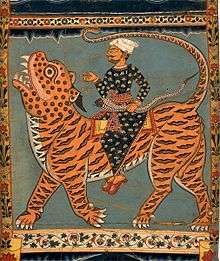Gazi Pir
- See also Gazi (disambiguation) and Ghazi

Gazi Pir (also called Ghazi Pir, Gaji Pir, Barkhan Gaji or Gaji Saheb) was a Bengali Muslim pir (saint) who lived in the twelfth or thirteenth-century during spread of Islam in Bengal. He was known for his power over dangerous animals and controlling the natural elements. As the new local Muslim population of southern Bengal were settling in the dense forests of the Ganges delta, these were important qualities. His life is shown on the "Gazi Scroll", a scroll with fifty-four paintings from around 1800 CE, which is currently in the British Museum in London.[1]
In the villages of the Sundarbans jungles, Gazi Pir is worshiped alongside the Bonbibi and the Hindu Dakshin Rai, to ask for protection from tigers. According to the legends, Bonbibi taught that everyone is equal, no matter the caste or religion that one has, and that they should live in harmony with nature.[2]
Kolkata memorial

Rani Rasmani, who created the Dakshineswar Kali Temple in Kolkata in 1847, saw Gazi Pir in a dream. In this dream he instructed her to construct a shrine for him under a peepal tree which is located outside what is now the riverside gate of Belur Math, which was built in the early 20th century. Ramakrishna Paramahansa used to offer "sinni" at this memorial.[3]
See also
References
- ↑ British Museum. The 'Gazi' Scroll.
- ↑ Jalais, Annu (2014). Forest of Tigers: People, Politics and Environment in the Sundarbans. Routledge. ISBN 978-1-136-19869-4.
- ↑ Chowdhury, Satyam Roy (2016). Sri Ramakrishna For You. Techno India. ISBN 9789384561192.
Further reading
- Bera, Gautam Kumar; Sahay, Vijoy S. (2010). In the Lagoons of the Gangetic Delta. Mittal Publications. ISBN 978-81-8324-343-8.
- Blurton, T. Richard (2006). Bengali Myths: The Legendary Past. British Museum. ISBN 978-0-7141-2436-0.